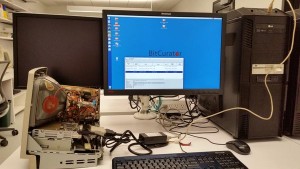Anyone who has worked with a computer for the past decade or longer probably has a few files saved on floppy disks, zip disks, CDs, and other assorted storage devices. Modern media like CDs and flash drives may still be accessible, but older disks are often unreadable by modern machines, left to languish in attics and filing cabinets.
The libraries and museums at Yale University are no different. Much of the digital media we have acquired over the last twenty years is trapped on legacy media requiring special hardware and software to access it. Despite the growing presence of born-digital archival material in Yale’s special collections, until now we have not created a system-wide approach to processing these holdings. Repositories with adequate funding and expertise are already providing access to born-digital, but many of these activities have been ad-hoc and the procedures differ based on available technology and expertise. Some repositories have postponed acquiring and processing born-digital media, deciding to wait for the libraries to create a holistic approach.
In January 2015 the Born Digital Working Group was formed to address this need and determine how the different libraries and museums can pool resources and expertise to find a path forward for born-digital archival materials. Our vision is to provide the same level of stewardship for born-digital holdings as is devoted to our physical collections. One of the priority goals is to establish a centralized Digital Accessioning Service for Yale special collections to capture files in a way that maintains their archival integrity and package them for ingest into the Digital Preservation System. This service is still in the beginning stages as we test software and hardware, draft documentation, and ensure that we are ready to begin accessioning archival material. The service will be housed in our new Di Bonaventura Family Digital Archaeology and Preservation Lab, allowing us to provide accessioning services for born-digital media from across Yale University Libraries and Museums.
Last April the Beinecke’s Technical Services department and the Preservation Department moved to a new facility that includes the shared Digital Archaeology and Preservation Lab. The space currently hosts disk imaging for special collections as well as disk imaging for the general collections managed by Euan Cochrane, Yale’s Digital Preservation Manager. The new lab has more room for collaborations and sharing expertise with staff and visitors. There is additional space and shelving for storage of supplies, tools, and media awaiting accessioning. The lab houses two workstations devoted to disk imaging for special collections, two workstations devoted to imaging disks from the general collection and additional write blockers.
The digital preservation team uses the lab to house legacy computers that can be used to view files in their original environment, interact with digital content that requires original hardware, and test and validate digital preservation approaches such as emulation and migration against the original content executing on contemporaneous legacy hardware. The Digital Preservation team is also creating disk images of the legacy computers which will be attached to emulated versions of the original hardware environments. Using images of the original hard drives with the emulated hardware will help to enable accurate validation of emulated hardware by removing one source of difference between the two environments. 
We use BitCurator, Forensic Toolkit (FTK), and Kryoflux to create disk images in the lab. Each offers different advantages for working with different media types. The extra room also means we can avoid the pesky traffic jams that came up in our former lab space in Sterling Memorial Library.
Now that we have the technology in place, we are working on documentation. That includes reference guides for write blockers, how-to manuals for disk imaging, and workflows to explain how media will make their way from collections through the accessioning process. All of this will inform the service, led by myself as the Digital Accessioning Archivist with the guidance of the Beinecke’s Digital Archivist and the Born Digital Working Group. I’ll be the new go-to person for born-digital accessioning here at Yale University’s Libraries and Museums. For the next month I’ll be focused on getting all our docs in a row so that we can begin accessioning digital media from archival collections across campus. I will also be visiting the various special collections and archives across campus to familiarize myself with the collections and processes in place, so we can make born-digital accessioning a seamless part of archival processing here at Yale. As the born-digital program continues to develop, we hope to invite the Yale community into the lab to learn more about our work with digital preservation, emulation tools, and disk imaging.
